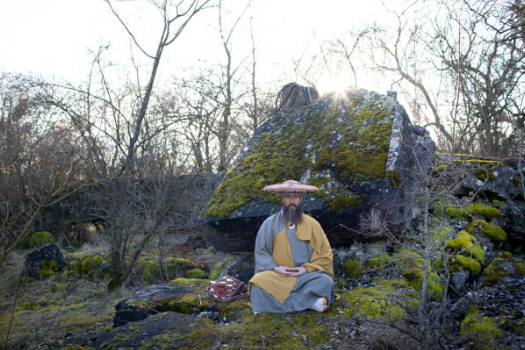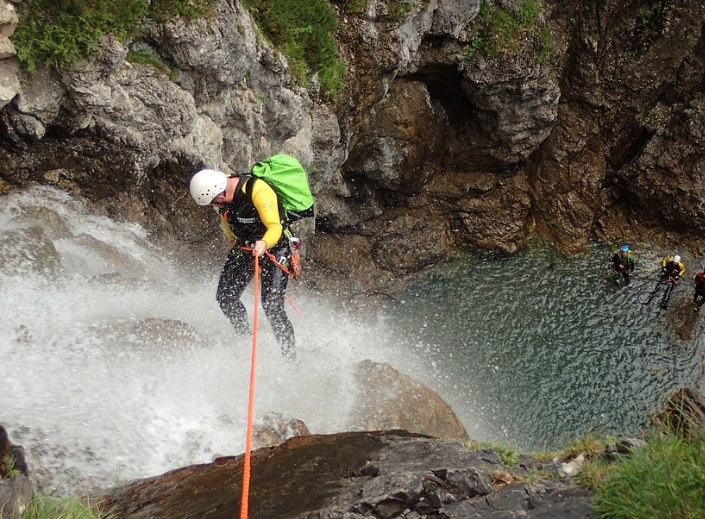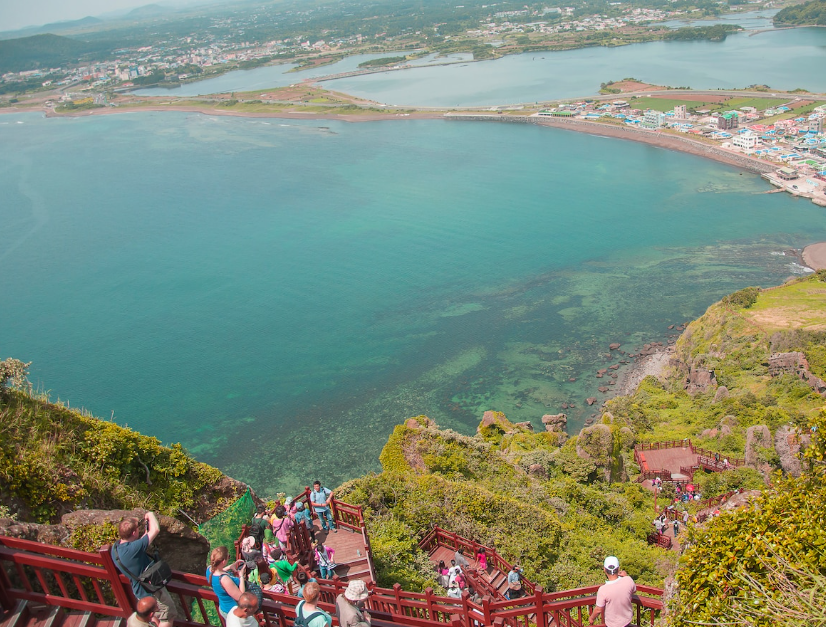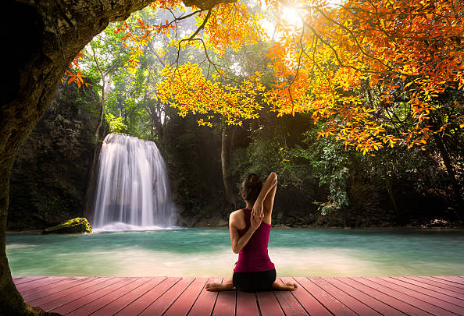Meditation Near Waterfall
Learn about meditation near the waterfall to help you blend into a peaceful environment.

Selfpause Affirmation App
Download the app to get 1,000’s of affirmation meditations and everything you need to write, record and listen to your own.
You can practice Yogasana meditation near the waterfall. The first step is to focus on breathing through your nose. This will help you merge with a peaceful environment. As you breathe in and out through your nose, you should notice any thoughts that come into your mind. Those thoughts and emotions are processes that happen in the present moment. By taking note of these thoughts and feelings, you will be able to focus on the present moment.
Takigyo

Takigyo, or meditation near a waterfall, is a traditional Japanese spiritual practice. It was once restricted to Buddhist monks, Shinto priests, and mountain monks, but it has recently become popular among the public. The ancient practice involves performing rituals and gestures that include prayer before entering the water. It is said that the waterfall cleanses the mind and soul. It can be performed in any season, but it is recommended that people try it at least once.
The water temperature is approximately 10 degrees Celsius, so participants can’t feel their toes. During the meditation, participants wear white clothes as a sign of purification. Takigyo meditation has become increasingly popular in recent years, as the coronavirus pandemic has led to increased stress. However, the benefits of takigyo aren’t limited to relieving stress.
When meditating near the Takigyo waterfall, it is important to practice mindfulness. Often, monks chant a particular mantra called the Hannya Shingyo, which is said to purify the mind of the person chanting it. Male monks chant the mantra seven times, while female monks chant it three times. While meditating, they also count the beads on their wrist, representing the 108 afflictions that humankind has brought on. They hope that at the end of the year, these afflictions will disappear.
The Takigyo waterfall is a sacred site of the ancient Japanese religion Shugendo. According to this practice, nature is populated with spirits. As such, the waterfall offers a unique experience to its visitors. Visitors can climb the mountain in the morning and meditate under the waterfall in the afternoon.
Akame waterfall experience

Visiting the Akame waterfall is an experience that can be described as a form of meditation in nature. The experience is open to people of all ages and beliefs. It is not a religious experience, but it can be a powerful one for those seeking spirituality without being religious. It begins by changing into a white kimono and sitting in front of the waterfall. The next step is to say a prayer.
The Akame 48 Waterfalls are a scenic valley of waterfalls located in Mie Prefecture. There are five main waterfalls and many smaller overflows. The valley was originally established as a Buddhist Shugendo practice center, and its name may refer to the 48 vows made by Amida Buddha. This peaceful location is also home to the Giant Salamander, a symbol of the sun.
The training sessions last about an hour, and you need to book in advance. It is recommended that you book with a group of two or more people. You can choose between a morning or afternoon session. In addition to meditation, you can also book eco-tours with the park. There are also activities for children, such as shower climbing and canyoning.
If you are looking for a truly unique waterfall meditation experience, the Akame waterfall is a great place to go. Unlike other waterfall meditation experiences, this experience is peaceful, inspiring, and rejuvenating. Be sure to take your time and enjoy the natural surroundings. You will find this place to be very different from the “Yamabushi experiences” that many tourists get.
Before beginning your meditation experience, make sure that you are physically fit. If you suffer from physical health issues, such as heart disease or alcohol consumption, this experience may not be for you. It is a form of self-discipline that can take you to a higher state of being.
Takigyo at Izurusan Manganji

People who practice meditation near waterfalls in Japan often seek a feeling of calm and refreshment. One of the most traditional forms is takigyo, or “praying with the water,” where the meditator stands at the foot of a waterfall and prays. The waterfall comes down straight onto the meditator, who is dressed in a white robe to represent the dead. This kind of meditation can last from one to 20 minutes.
Takigyo, which translates to “let the water wash over us,” is an important practice in Japan that is widely practiced in the country. The main purpose of this type of meditation is to purify the mind and body. This type of practice is often done under waterfalls so that the water will “wash away” any mental impurities and distractions.
Before entering the water, meditators bow to the waterfall and say their full name. They then turn around and let the water wash over them. During this time, they may splash themselves with the water. This practice is also a part of the Japanese culture, although it isn’t recommended for safety reasons.
The water is very cold, so visitors should wear white kimonos to be completely protected from the elements. Afterward, they can sit on a rock at the base of the waterfall to meditate. If you feel shy or are too shy, you can also use a small tent at the base of the waterfall.
Yogasana meditation near the waterfall

This free photo of Yogasana meditation near the waterfall is available for personal and commercial use. You can use it in a variety of applications such as advertisements, UI designs, product packaging, and websites. It is available under both the Standard and Extended License. The Standard License allows for most uses such as advertising and websites, and the Extended License allows for more extensive use including unlimited print rights, merchandise resale, and free distribution.
Our Top FAQ's
Meditating near a waterfall can provide several potential benefits. The sound of the waterfall can help to drown out external distractions and promote a state of relaxation and inner calm. The natural setting of a waterfall can also help to connect the meditator with nature, which can in turn help to reduce stress and improve overall well-being. Additionally, the fresh air and natural beauty of a waterfall can provide a sense of awe and inspiration that can enhance the meditative experience.
To find a suitable waterfall for meditation, you can do a search online for waterfalls in your area. You can also ask for recommendations from friends, family, or local outdoor enthusiasts. Once you have found a few potential options, you can visit the waterfall in person to see if it feels like a good fit for your meditation practice. Some factors to consider when choosing a waterfall for meditation include the location, accessibility, and the overall ambiance of the setting.
Here are a few tips for meditating near a waterfall:
- Find a comfortable and stable seating position, such as sitting on a blanket or a meditation cushion.
- Take a few deep breaths to relax and settle into the meditation.
- Focus your attention on the sound of the waterfall, allowing it to be the object of your meditation.
- If your mind starts to wander, gently bring your attention back to the sound of the waterfall.
- Remember to stay present and enjoy the experience, rather than trying to achieve any specific outcome.
- When the meditation is over, take a few moments to stretch, take in your surroundings, and gradually re-enter the world.
Meditating near a waterfall can be a peaceful and enjoyable experience, but it is important to be mindful of potential dangers or drawbacks. For example, if you are meditating near a large or fast-flowing waterfall, there may be a risk of falling or being swept away by the water. Additionally, waterfalls can be located in remote or rugged areas, so it is important to be prepared for the elements and to have appropriate clothing, supplies, and safety equipment. Finally, waterfalls can be popular tourist attractions, so there may be other people around who could potentially disturb your meditation.
One common misconception about meditating near a waterfall is that it is only for advanced meditators or experienced outdoor enthusiasts. In reality, anyone can meditate near a waterfall, regardless of their level of experience or fitness. Another misconception is that meditating near a waterfall is inherently more beneficial than meditating in other settings. While a waterfall can provide a beautiful and peaceful setting for meditation, the benefits of meditation come from the practice itself, rather than the specific location. Finally, some people may believe that meditating near a waterfall requires special techniques or rituals, but in reality, the most important thing is to simply focus on your breath and bring your attention to the present moment.
